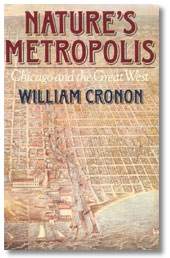Author: William Cronon
Title: Nature’s Metropolis: Chicago and the Great West
Publication Info: New York: W.W. Norton & Company, Inc., 1991 
Summary/Review:
Favorite Passages:
“For [Louis] Sullivan, the wonder of Chicago was the wonder of nature transformed: the more nature had been reworked by an inspired human imagination, the more beautiful it became. It served as the vehicle and occasion for expressing human spirit.’ – p. 14
We “moderns” believe, even in a postmodern age, that we have the power to control the earth, despite our deep ambivalence about whether we know ow to exercise that power wisely. On the other hand, our nostalgia for the more “natural” world of an earlier time when we were not so powerful, when the human landscape did not seem so omnipresent, encourages us to seek refuge in pastoral or wilderness landscapes that seem as yet unscarred by human action. Convinced of our human omnipotence, we can imagine nature retreating to small islands – “preserves” – in the midst of a landscape which otherwise belongs to us. And therein lies our dilemma: however we wish to “control” nature or “preserve” it – we unconsciously affirm our belief that we ourselves are unnatural. Nature is the place where we are not. – p. 18
“Chicago’s population exploded after 1833 without bothering much about a pastoral stage, a settlement of pioneering subsistence farmers, or even an agricultural community at all. The town’s speculators gambled on and urban future, staking fortunes on land they hoped would soon lie at the heart of a great city. Explaining their vision of Chicago’s ‘destiny’ means reading Turner backward, for their theory of frontier growth apparently began with the city instead of ending with it.” – p. 32
“The changes in Chicago’s markets suddenly made it possible for people to buy and sell grain not as the physical product of human labor on a particular tract of prairie earth but as an abstract claim on the golden stream flowing through the city’s elevators.” – p. 120
“The futures market was a market not in grain but in the price of grain. By entering into futures contracts, one bought and sold not wheat or corn or oats but the prices of those goods as they would exist at a future time. Speculators made and lost money by selling each other legally binding forecasts of how much grain prices would rise or fall.” – p. 125
“The land might have been taken from Indians, its profits might sometimes have been expropriated by absentee landlords, its small farmers might on occasion have suffocated beneath a burden of accumulating debt, but much of what made the land valuable in the first place had little to do with the exploitation of people. The exploitation of nature came first.” – p. 150
“Animals’ lives had been redistributed across regional space, for they were born in one place, fattened in another, and killed in still a third.” – p. 224
“The cattle that grazed on a Wyoming hillside, the corn that grew in an Iowa field, and the white pine that flourished in a Wisconsin forest would never ordinarily have shared the same landscape. All nonetheless came together in Chicago. There they were valued according to the demands and desires of people who for the most part had never even seen the landscapes from which they came. In an urban market, one could by goods from hinterlands halfway round the world without understanding much if anything about how the goods had come to be there. Those who bought plants and animals from so far away had little way of knowing the ecological consequences of such purchases, so the separation of production and consumption had moral as well as material implications.” – p. 226
“Once a product had been processed, packaged, advertised, sold, and shipped within the long chain of wholesale-retail relationships, its identity became more and more a creature of the market. The natural roots from which it had sprung and the human history that had created it faded as it passed from hand to hand. Wherever one bought it, that was where it came from.”- p. 340
“We are consumers all, whether we live in the city or the country. This is to say that the urban and the rural landscapes I have been describing are not two places but one. They created each other, they transformed each other’s environments and economies, and they now depend on each other for their very survival. To see them separately is to misunderstand where they came from and where they might go in the future. Worse, to ignore the nearly infinite ways they affect one another is to miss our moral responsibility for the ways they shape each other’s landscapes and alter the lives of people and organisms within their bounds. The city-country relations I have described in this book now involve the entire planet, in part because of what happened to Chicago and the Great West during the nineteenth century. We all live in the city. We all live in the country. Both are second nature to us.” – p. 384-385
Recommended books:
- Railroaded: The Transcontinentals and the Making of Modern America by Richard White
- The Devil in the White City by Erik Larson
- The Third Coast: When Chicago Built the American Dream by Thomas Dyja
Rating: ****
